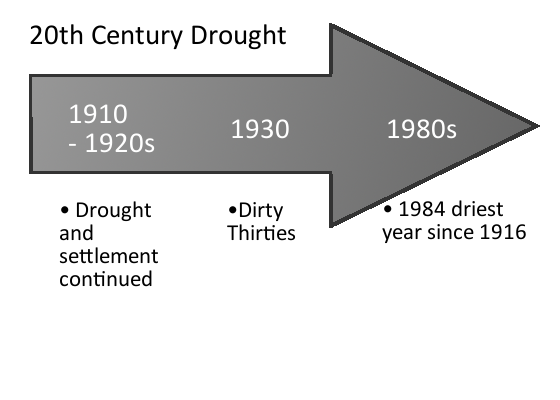Drought in 20th Century Alberta

The Wheat Boom
Despite the drought in 1885 – 1896, settlement continued across the Prairies into the 1920s. Although the early years of the 19th century were wetter, drought returned during the years of 1910, 1914, 1917, 1918 and 1919, and the drought between 1917-1926 was considered to be especially bad [i].
Although drought was having a negative impact in the West, the federal government continued to actively promote immigration (Figure 1). The late 1920s brought particularly good crop yields. wheat became the key crop in the Prairie Provinces – making it Canada’s largest single export commodity [ii].
The Dirty Thirties
The global stock market collapsed in 1929 and marked the beginning of the Great Depression. To make matters worse, a severe drought began in the prairies in 1929. This drought resulted in grasshopper plagues, crop failure, erosion of topsoil and soil salinization [iii]. The drought had a major impact on crops – most notably wheat – and what was once a booming economy based on agriculture slowed drastically.
Drought continued into the 1930s. In the Canadian Prairie Provinces, the value of wheat was greatly reduced in the global export market [iv]. The dire economic circumstances caused by drought and compounded by the Great Depression resulted in a wave of settlers leaving the Prairie Provinces for other parts of Canada.
This time period is often referred to as the “dust bowl” because the dry conditions resulted in regular dust storms across the North American prairies.
By the mid-thirties, so many people were leaving their homesteads in the prairies that it appeared that agriculture would not be a major industry in the future. The federal government decided that something had to be done, and in 1935, it passed the Prairie Farm Rehabilitation Act (PFRA), which was meant to give encouragement to farmers by addressing water and land management challenges related to agriculture. According to the government of Canada, “it was obvious that drastic and far-reaching steps would have to be taken immediately if prairie agriculture was to regain its position in the Canadian economy and go forward on a sound and permanent basis” [v].
In 1938, the Government of Alberta established the Special Areas Board. The purpose of this Board was to govern areas of Alberta (now known as the “Special Areas”) that were hit particularly hard by the drought. The Special Areas and Special Areas Board are still in existence today.
Following the Dirty Thirties, major droughts did not occur until the 1980s. There were no severe multi-decade droughts between the 1930s and 1980s, although it should be mentioned that there were single year droughts in 1961 and 1977 [vii].
Drought in the 1980s
After the Depression, there was not another major drought until 1979. The 1979 drought marked the beginning of a series of droughts, which cost the Canadian economy billions of dollars.
By 1984, the drought became severe; it was the eighth consecutive dry year in a row and the worst driest year since 1916. To help alleviate pressure felt by farmers, Alberta Premier Peter Lougheed announced that construction of a dam (which would later become the Oldman River Dam) would begin in 1986 (construction did not actually begin until 1992). The Government’s decision was highly contentious and resulted in protests from the Peigan community [viii].
In Saskatchewan, meanwhile, the Province built the Gardiner Dam and the Qu-Appelle River Dam to create Lake Diefenbaker in 1967 [ix] which provides irrigation for almost 43,000 hectares of farmland [x].
Despite the difficulties of drought during these decades, studies have shown that the “climate of the 20th century was anomalous in terms of absence of sustained drought and the climate normal period of 1961-1990 may have been among the most benign of the past 750 years” [xi].
In closing, we should note that droughts in Western Canada are expected to become more frequent and severe in the 21st century [xii].
Sources:
[i] Marchildon, G. P. (2006, September 4). Institutional Adaptation to Drought in the Special Areas of Alberta, 1909 – 1939. Retrieved from http://www.parc.ca/mcri/pdfs/iaccspecareas.pdf. Accessed 2023-05-01.
[ii] Canada Department of Agriculture. (1961). Prairie Farm Rehabilitation Act: What it means to the Prairie Provinces. Retrieved from https://archive.org/stream/pfraprairiefarmr00cana#page/n3/mode/2up. Accessed 2023-05-01.
[iii] Bailey, A., Schellenberg, M. P., McCartney, D., & Bailey, P. (2010, October). Politics, Policy, Settlers, and Consequences for Canadian Prairie Grasslands: A Range Management Perspective. Rangelands: Society for Range Management. Retrieved online http://journals.uair.arizona.edu/index.php/rangelands/article/download/19012/18773. Accessed 2023-05-01.
[iv] The Encyclopedia of Saskatchewan | Great Depression (uregina.ca). Accessed 2023-05-01.
[v] Canada Department of Agriculture. (1961). Prairie Farm Rehabilitation Act: What it means to the Prairie Provinces. Retrieved from https://archive.org/stream/pfraprairiefarmr00cana#page/n3/mode/2up. Accessed 2023-05-01.
[vi] Image retrieved from http://specialareas.ab.ca/downloads/maps. Accessed 2023-05-01.
[vii] Khandekar, M. L.(2004). Canadian prairie drought : a climatological assessment – Open Government (alberta.ca). Accessed 2023-05-01.
[viii] Historical Chronology of the Oldman River Dam Conflict (parc.ca)
[ix] Lake Diefenbaker – Water Security Agency (wsask.ca). Accessed 2023-05-01.
[x] Lake Diefenbaker: Saskatchewan’s “Great” Lake (tourismsaskatchewan.com). Accessed 2023-05-01.
[xi] Sauchyn, Dave et al. (2002) “Aridity on the Canadian Plains: Future Trends and Past Variability.” Prairie Adaptation Research Collaborative. Sauchyn, D.J., et al, 2002, Aridity_on_the_Canadain_Plains.pdf (parc.ca). Accessed 2023-05-01.
[xii] Drought (canada.ca). Accessed 2023-05-01.
